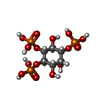+Search query
-Structure paper
| Title | Structural titration reveals Ca-dependent conformational landscape of the IP receptor. |
|---|---|
| Journal, issue, pages | Nat Commun, Vol. 14, Issue 1, Page 6897, Year 2023 |
| Publish date | Oct 28, 2023 |
 Authors Authors | Navid Paknejad / Vinay Sapuru / Richard K Hite /  |
| PubMed Abstract | Inositol 1,4,5-trisphosphate receptors (IPRs) are endoplasmic reticulum Ca channels whose biphasic dependence on cytosolic Ca gives rise to Ca oscillations that regulate fertilization, cell division ...Inositol 1,4,5-trisphosphate receptors (IPRs) are endoplasmic reticulum Ca channels whose biphasic dependence on cytosolic Ca gives rise to Ca oscillations that regulate fertilization, cell division and cell death. Despite the critical roles of IPR-mediated Ca responses, the structural underpinnings of the biphasic Ca dependence that underlies Ca oscillations are incompletely understood. Here, we collect cryo-EM images of an IPR with Ca concentrations spanning five orders of magnitude. Unbiased image analysis reveals that Ca binding does not explicitly induce conformational changes but rather biases a complex conformational landscape consisting of resting, preactivated, activated, and inhibited states. Using particle counts as a proxy for relative conformational free energy, we demonstrate that Ca binding at a high-affinity site allows IPRs to activate by escaping a low-energy resting state through an ensemble of preactivated states. At high Ca concentrations, IPRs preferentially enter an inhibited state stabilized by a second, low-affinity Ca binding site. Together, these studies provide a mechanistic basis for the biphasic Ca-dependence of IPR channel activity. |
 External links External links |  Nat Commun / Nat Commun /  PubMed:37898605 / PubMed:37898605 /  PubMed Central PubMed Central |
| Methods | EM (single particle) |
| Resolution | 2.5 - 5.55 Å |
| Structure data | EMDB-41323, PDB-8tk8:  EMDB-41324: Human Type 3 IP3 Receptor - 3:1 Resting-to-Preactivated Transition State  EMDB-41325: Human Type 3 IP3 Receptor - 2:2 Resting-to-Preactivated Transition State  EMDB-41326: Human Type 3 IP3 Receptor - 1:3 Resting-to-Preactivated Transition State  EMDB-41327: Human Type 3 IP3 Receptor - ARM2 Retraction Figure 4B  EMDB-41328: Human Type 3 IP3 Receptor - ARM2 Retraction Figure 4C  EMDB-41329: Human Type 3 IP3 Receptor - ARM2 Retraction Figure 4D  EMDB-41330: Human Type 3 IP3 Receptor - ARM2 Retraction Figure 4E  EMDB-41331: Human Type 3 IP3 Receptor - ARM2 Retraction Figure 4F  EMDB-41332: Human Type 3 IP3 Receptor - ARM2 Retraction Figure 4G  EMDB-41333: Human Type 3 IP3 Receptor - Wedge Loop Melting Progression Figure S15N  EMDB-41334: Human Type 3 IP3 Receptor - Wedge Loop Melting Progression Figure S15I  EMDB-41335: Human Type 3 IP3 Receptor - Wedge Loop Melting Progression Figure S15K  EMDB-41336: Human Type 3 IP3 Receptor - Wedge Loop Melting Progression Figure S15M  EMDB-41337: Human Type 3 IP3 Receptor - Wedge Loop Melting Progression Figure S15L  EMDB-41338: Human Type 3 IP3 Receptor - Wedge Loop Melting Progression Figure S15J  EMDB-41339: Human Type 3 IP3 Receptor - C2 Preactivated TMD Transitions (Figure 6D)  EMDB-41340: Human Type 3 IP3 Receptor - C4 Preactivated TMD Transitions (Figure 6E)  EMDB-41341: Human Type 3 IP3 Receptor - Activated CTD Frame 1 (Figure S18B)  EMDB-41342: Human Type 3 IP3 Receptor - Activated CTD Frame 2 (Figure S18B)  EMDB-41343: Human Type 3 IP3 Receptor - Activated CTD Frame 3 (Figure S18B)  EMDB-41344: Human Type 3 IP3 Receptor - C2 Resting TMD Transitions (Figure S8D)  EMDB-41345: Human Type 3 IP3 Receptor - C4 Resting TMD Transitions (Figure S8E) EMDB-41347, PDB-8tkd: EMDB-41348, PDB-8tke: EMDB-41349, PDB-8tkf: EMDB-41350, PDB-8tkg: EMDB-41351, PDB-8tkh: EMDB-41352, PDB-8tki: EMDB-41365, PDB-8tl9: EMDB-41366, PDB-8tla: |
| Chemicals |  ChemComp-ZN:  ChemComp-I3P:  ChemComp-ATP:  ChemComp-PCW:  ChemComp-CA:  ChemComp-PT5:  ChemComp-HOH: |
| Source |
|
 Keywords Keywords |  TRANSPORT PROTEIN / TRANSPORT PROTEIN /  Ion Channel / Ion Channel /  Calcium Channel / Calcium Channel /  Endoplasmic Reticulum Endoplasmic Reticulum |
 Movie
Movie Controller
Controller Structure viewers
Structure viewers About Yorodumi Papers
About Yorodumi Papers






















